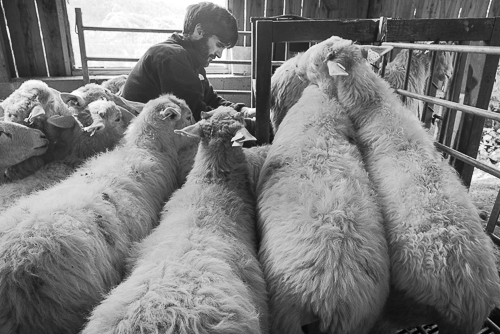My guide asked Jose Ramon Aguirre «Marron», a versatile man (photographer, alpinist and blogger) in charge of Lizarrusti House (Environmental Center, Tavern and Hostel) in the Natural Park of Aralar to bring us by car from the town of Ataun to the Aralar mountain range via curvy mountain roads and through forests until we reached a lovely area with rolling hills and meadows where horses, cows and sheep were grazing. Finally, we arrived at the mortared stone house of Joseba Insausti, a shepherd only 30 years old, but who has already been doing this work for 19 years, an early start indeed!. Since this area is usually covered by several metres of snow in winter, local farmers practise transhumance, that is they bring their animals in a van to the mountains in late spring and walk down to the valleys in autumn. Transhumance, man bringing animals to the mountains in summer and to the valleys in winter, has been practised for millennia worldwide, but nowadays it is done only in a few a places due to factors like national borders, heavily trafficked roads, only a few who want to be a shepherd, etc.
Having entered the house, Jose Ramón led us through the house to a small annex where Joseba was milking his Latxa sheep manually. All the sheep were inside an enclosure next to the house and Joseba ordered his shepherd dog to chase the sheep against him by issuing short, sharp commands in Basque. Then, the sheep had to enter a small cage one by one. Depending on if it was a lamb or a ewe, he let the first ones pass, while he closed a small gate if it was a ewe. In the latter case, he milked it by hand, letting the milk into a bucket. When he was finished, he opened the gate such that the ewe could pass. This procedure was repeated until the bucket was full at which moment he poured its contents into a container through a filter of porous cloth. Then, he went back to his milking place and let the next sheep enter the cage. As the number of sheep decreased, the remaining ones weren’t entering the cage willingly, making Joseba order his shepherd dog more frequently to move the sheep against the cage.
Having milked all the sheep, he brought the milk container to the other part of the hut where there was a small dairy, which is called Otatza de Ordizia. There, he poured the contents of the container through another filter into a rectangular vessel. Having added rennet, which is used to turn milk into curd, he lit a gas fire below the vessel to heat the milk to about 38ºC and stirred the milk for some time. Then, we had to wait for about for about half an hour until the milk started coagulating, meaning it was being turned into curd.
Afterwards, he used a utensil, which is commonly called a harp or a guitar, because it consists of a metal frame crossed by parallel wires. Moving the harp through the curd in various directions, it is broken up into solid and liquid parts. Next, he spent some time stirring the mixture in order to make it even. Finally, he put a a perforated metal plate into the container and pressed it towards the mixture such that the liquid parts, called whey, flowed out through the holes in the plate, while the solid parts remained. Compressing the solid parts further, a thick block of cheese mass was formed, while the whey was removed by compressing the cheese mass. Next, he used a knife to cut up the cheese mass in cubes with a length of about 12 cm, which he put into circular containers. However, he had already put a porous piece of cloth in each container such that it would be easier to extract the cheese mass from the container at a later date. At last, he put first a label to get traceability, then a a lid on each circular container and put all of them under pressure to press out as much whey as possible.
Joseba brings his sheep to the mountains in early May and he brings them back to the lowlands in November. He milks the sheep twice daily and he works 12-hour days. There are lots of mortared stone houses in this area and he told my guide that up to 47 shepherds may be staying in this area in season. During our stay, horses and cattle were walking around freely and a car with a trailer even brought two cows, which were released in the same area.
He has two labels for his cheeses: one for mountain cheese and one for valley cheese. In 2015, he won two prizes: the first prize for the best sheep cheese of Spain and the first prize in «Premio Mejores Quesos Españoles» or «Best Spanish Cheeses Award».
He considers what he’s doing not a job, but a way of life.

